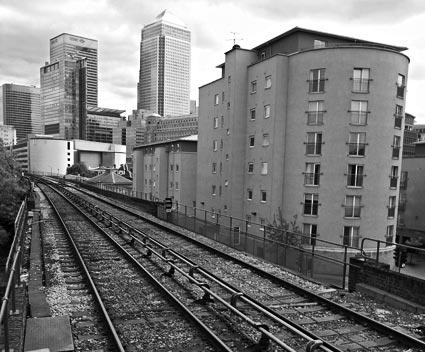|
A trip to London's Docklands
Daytrip to North Woolwich and Silvertown
Mike Slocombe, May 2006
An afternoon spent exploring London's rapidly changing Docklands
(Camera used: Ricoh GRD)

Looking towards Canary Wharf from Westferry. 'Eck, I remember when it were all knackered warehouses and industrial dereliction...

Imposing facade of the Spillers Millennium Mills, on the south side of the Royal Victoria Dock.
Standing by the banks of the river Thames, this was one of the largest mill complexes ever to be built in London, processing huge quantities of grain.
Closed for decades, this landmark building awaits the inevitable conversion into 'loft style apartments.'

London's first major public parkland project for over 50 years, Thames Barrier Park occupies 22 acres of former wharf space.
There's a nice Visitor Pavilion close to the Pontoon Dock DLR station too - great for a relaxing coffee!


The world's second largest movable flood barrier, the Thames Flood Barrier was opened in 1984, covering a 523 metre wide stretch of the river.
The barrier is made up of six navigable and four smaller non-navigable channels situated between nine large concrete piers.

DLR overhead line to King George V dock.

The closed Graving Dock Tavern, 353 North Woolwich Road, Silvertown (Graving docks were used for cleaning ships hulls).
Built on the site of the original Victorian pub around 1960, the Tavern awaits its fate behind steel railings as the 'Silvertown Quays' development prepares to flatten the site.


Poignant archive photo from 1986 showing publicans 'Mr. & Mrs. Jeffries when they took over the pub.' [Source: essexpub.net]

Old level crossing gates, Silvertown. See Silvertown station feature
On Friday the 19th of January, 1917, at 6:52 pm, London's loudest-ever explosion took place close to the site, with the shock-wave felt all over London and Essex, and heard over 100 miles in Southampton.
The explosion came from a nearby TNT purifying plant, which instantly ignited 50 tons of TNT loaded into nearby railway wagons.
The damage was immense, with fires being started for miles around and an estimated 60 to 70,000 properties receiving damage.
Despite the immensity of the explosion, a comparatively small 73 people were killed and over 400 were injured - the low casualty figure thanks to the blast taking place at the end of the 'working week,' where most workers had already left the factories.

Cundy's Tavern, 2-4 Connaught Road, Silvertown.
Formerly the Railway Tavern, this high-ceilinged, old-school Victorian boozer looks as rough inside as it does on the outside, with the walls bedecked with West Ham football shirts and England flags.


The former 1887 Tate Institute, on the corner of Wythes Road and Connaught Road, Silvertown.
Built by Sir Henry Tate for his sugarworkers, Sir William Tate donated £1,500 to renovate the institute in 1904 , adding another £�1,200 to endow it two years later.
The institute was closed in 1933 and the building sold.
Now boarded up, the top floor of this attractive building served as the Silvertown library between 1938-61, with the ground floor being used by the Institute, which held regular social events for Tate & Lyle employees at the factory opposite.

Looking west towards Silvertown. To the left of the railway track is Factory Road, with Albert Road to the right.

Closed pub across the tracks, Albert Road, Silvertown.


A Richmond-bound train from North Woolwich rattles under the rather delicate-looking footbridge.

Another closed pub, Three Crowns, Pier Head, North Woolwich.
In the 1980s, the pub used to close at 10:30 while the pubs on the opposite side of the river would still be open
to 11 - a quirk of the licensing laws that would often send drinkers hot-footing it through the river foot tunnel to catch another pint or two!
This pub also had something of a rough reputation with 'regular fights.'

A sea of BT satellite dishes, by North Woolwich station.


Woolwich foot tunnel.
There's been a ferry across the Thames linking Woolwich with North Woolwich since 1308, with a Penny Ferry running from the mid 19th century to 1908 until being superceded by the Free Ferry which started operating in 1889.
The service was originally run by paddle steamers, replaced by 3 diesel vessels in 1963.
A foot tunnel was opened in 1912 (the first 1876 attempt failed) which remains open to passengers for free.

Signpost and crumbling wall, North Woolwich.
|